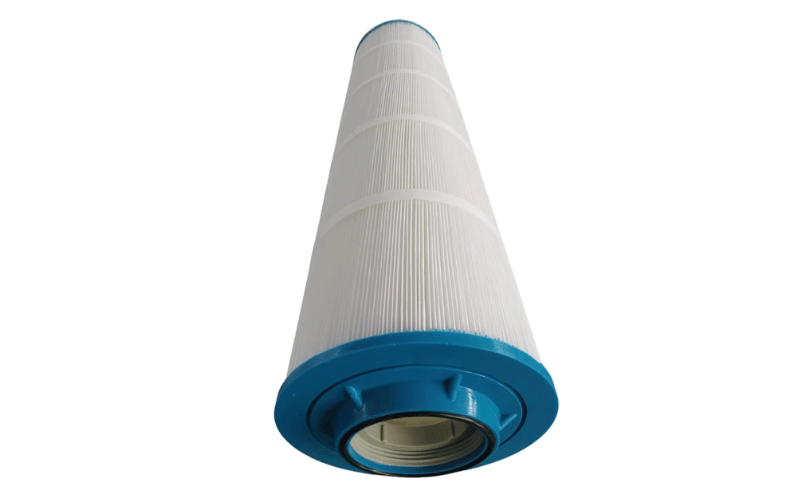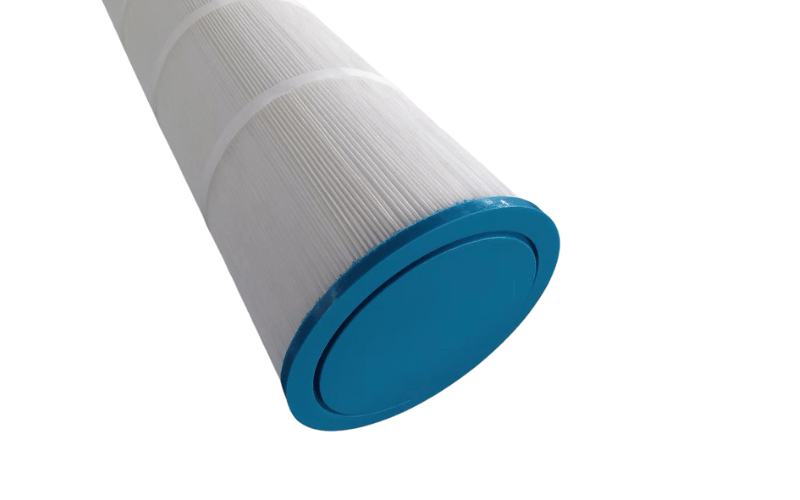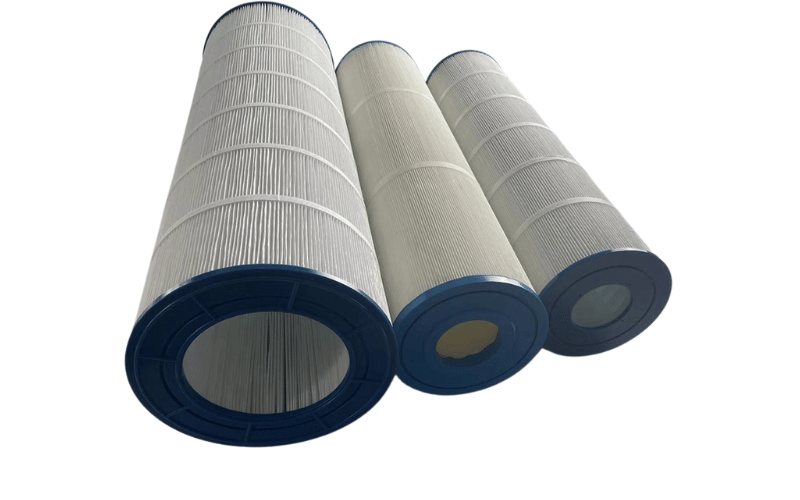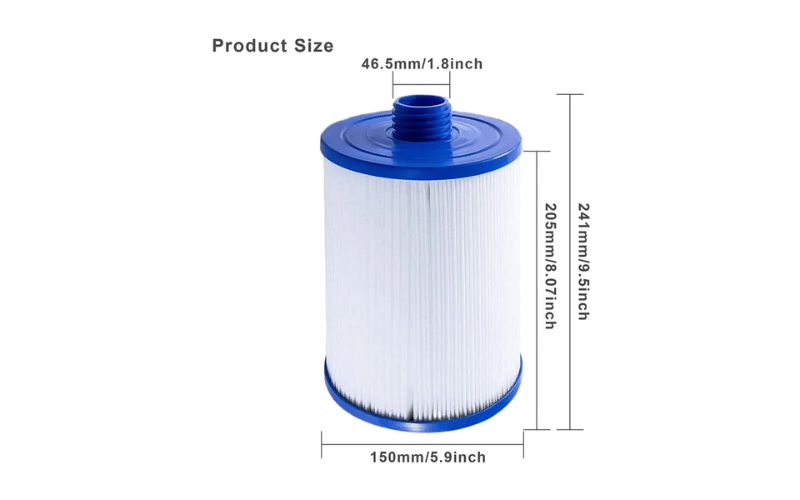Pool Filter Cartridge
Home » Water Filter Cartridge » Pool Filter Cartridge
Efficient Filtration | Long Service Life | Customizable Options
Our Pool Filter Cartridge is designed for efficient filtration in swimming pools, spas, and hot tubs, ensuring crystal-clear water by trapping dirt, debris, and contaminants. Compatible with standard 4-15/16″ (127mm) housings, it offers high dirt-holding capacity and durability for residential and commercial applications .
Key Features:
- Premium Filtration Media – Constructed with a 180-pleat design for maximum surface area (50 sq. ft.) and superior particle retention.
- Precise Compatibility – Fits 4-15/16″ (127mm) diameter housings with a 46.5mm internal SAE thread at the base and semi-circular top handle for easy installation.
- Robust Build – Made from FDA-compliant materials (where applicable), resistant to chlorine and chemicals for long service life.
- High Flow Rate – Optimized pleat spacing minimizes pressure drop, maintaining water circulation efficiency.
- Easy Maintenance – Rinseable and reusable, reducing operational costs.
Technical Specifications
| Parameter | Specification |
|---|---|
| Outer Diameter (OD) | 7.8cm -10.8cm |
| Length/Height | 7.4cm - 20cm |
| Filtration Accuracy | 25 Um |
| Color Options | Blue, Gray, White, Etc. |
| Construction Materials | Polyethylene Terephthalate (PET), Polyurethane (PU), Polypropylene (PP) |
| Minimum Order Quantity (MOQ) | 50 PCs |
Applications:
- Residential/commercial swimming pools
- Spa and hot tub filtration systems
- Water parks and public aquatic facilities
Quality Assurance:
- ISO 9001-certified production (inferred from Hangzhou Darlly’s standards).
- Customizable options (micron rating, material) are available for OEM/ODM demands.
What is a Pool Filter Cartridge?
A pool filter cartridge is a key component in a cartridge filtration system, which is one of the three main types of pool filtration systems (alongside sand filters and DE (diatomaceous earth) filters).
What Does a Pool Filter Cartridge Do?
It captures dirt, debris, and small particles from pool water as water flows through it. The cartridge is made of pleated fabric (usually polyester or paper-like material) that traps contaminants while allowing clean water to pass through.
Key Features:
✔ Pleated Design – Increases surface area for better filtration.
✔ Reusable – Can be cleaned by hosing off or soaking in a filter cleaner.
✔ Fine Filtration – Typically filters particles as small as 10-20 microns (better than sand filters but slightly less than DE filters).
✔ Low Maintenance – No backwashing required (unlike sand filters).
When to Replace It?
- When cleaning no longer restores the water flow.
- If the pleats are damaged or collapsing.
- Typically lasts 1-2 years, depending on usage and maintenance.
Pros & Cons:
✅ Pros:
- Energy-efficient (lower pressure than sand filters).
- Easy to maintain (rinse or soak).
- Suitable for pools with acceptable debris (pollen, small particles).
❌ Cons:
- Needs regular cleaning (every few weeks in peak season).
- Replacement costs add up over time.
Final Thought:
A pool filter cartridge is an excellent choice if you want better filtration than sand without the complexity of DE filters. Regular cleaning helps extend its lifespan, keeping your pool water crystal clear.
Would you like recommendations on cleaning or replacement brands? 😊
How to Maintain Your Pool Filter Cartridge?
Proper maintenance ensures peak performance, extends cartridge lifespan by 2-3 years, and keeps your pool crystal clear. Follow this professional maintenance routine:
1. Cleaning Schedule & Techniques
Weekly Maintenance:
- Visually inspect for:
✓ Debris accumulation (leaves, insects)
✓ Pleat deformation (folding/collapsing)
✓ Discoloration (brown = dirt, white = calcium)
Monthly Deep Clean:
Rinse Technique:
- Use 40° fan nozzle at 45° angle to pleats
- Start from the top, working downward (prevents debris compaction)
Chemical Soak (Every 3-6 Months):
- Standard Cleaning: Trisodium phosphate (1 cup per 5 gallons of water)
- For Oil Removal: Degreaser solution (10:1 water: Simple Green)
- Mineral Deposits: Muriatic acid soak (20:1 dilution, 30 mins max)
2. Replacement Indicators
Create a decision matrix for replacements:
| Symptom | Action | Urgency |
|---|---|---|
| PSI 10+ over clean rating | Deep clean | Moderate |
| Visible pleat tears >1″ | Immediate replacement | Critical |
| 3+ years old | Proactive replacement | Preventive |
| Cloudy water post-cleaning | Check chemistry + replace | High |
Pro Tip: Mark installation date on cartridge endcap with a permanent marker.
3. Advanced Maintenance Protocol
Quarterly Tasks:
- Inspect and lubricate the O-ring with 100% silicone grease
- Check filter housing for cracks/leaks
- Verify pressure gauge accuracy
Pre-Winterization:
- Perform final chemical cleaning
- Air-dry altogether (48 hours minimum)
- Store vertically in a breathable bag
Water Chemistry Connection:
Maintain these levels to extend cartridge life:
- Chlorine: 1-3 ppm
- pH: 7.4-7.6
- Calcium: 200-400 ppm
4. Cost-Saving Strategies
- Rotation System: Keep two cartridges (use one while cleaning the other)
- Quality Investment: Premium cartridges (Pleatco/Unicel) last 2x longer than generics
- Debris Prevention: Add skimmer socks (reduces cleaning frequency by 40%)
Bottom Line:
A disciplined maintenance routine can extend your cartridge’s lifespan to 5+ years: record cleaning dates and filter performance in a maintenance log for best results.
Need Specific Advice?
Ask about:
- Saltwater pool maintenance variations
- High-debris environment solutions
- Commercial pool protocols
How to Choose the Right Cartridge Pool Filter?
Here’s a structured guide on choosing the right cartridge pool filter, incorporating key considerations and expert insights:
How to Choose the Right Cartridge Pool Filter
Cartridge pool filters offer superior filtration and lower maintenance compared to sand or DE filters, but selecting the right one depends on several factors. Here’s what to prioritize:
1. Determine the Correct Size
- Flow Rate Compatibility: Match the filter’s GPM (gallons per minute) rating to your pump’s output.
- Example: A 100 GPM pump requires a filter rated for at least 100 GPM.
- Pool Volume: Larger pools need larger filters (measured in square feet of filtration area).
- <15,000 gallons: 100–200 sq. ft. cartridge
- 15,000–30,000 gallons: 200–400 sq. ft.
- >30,000 gallons: 400+ sq. ft. (or multiple cartridges).
2. Material & Durability
- Pleated Polyester: Standard for most pools; balances cost and efficiency.
- Reinforced Membranes: For heavy debris or commercial use (e.g., Pleatco’s Dura-Pleat).
- Stainless Steel Cores: Resists corrosion in saltwater pools.
3. Micron Rating (Filtration Precision)
- 20–50 microns: Standard for residential pools (removes fine dirt/pollen).
- 5–10 microns: High-efficiency (e.g., for spas or allergy sufferers).
4. Ease of Maintenance
- Self-Cleaning Models: Some filters (like Hayward’s “Clean & Clear”) include backwash-free designs.
- Cartridge Lifespan: Cheaper cartridges may need replacement yearly; premium ones last 3–5 years.
5. Brand & Warranty
- Top Brands: Pentair, Hayward, and Waterway offer reliable warranties (3–5 years).
- Avoid Generic Cartridges: Poor fit or materials can damage the filter housing.
Comparison: Cartridge vs. Sand/DE Filters
| Feature | Cartridge Filter | Sand Filter | DE Filter |
|---|---|---|---|
| Filtration | 20–50 microns | 20–40 microns | 1–5 microns |
| Maintenance | Clean every 2–3 months | Backwash weekly | Backwash + DE recharge |
| Cost | $$ (moderate) | $ (low) | $$$ (high) |
Pro Tips
- Oversize for Less Cleaning: A 400 sq. ft. filter in a 20,000-gallon pool reduces cleanings by 50%.
- Pair with a Skimmer Sock: Pre-filters debris to extend cartridge life.
- Check Local Regulations: Some areas restrict DE filters due to environmental concerns.
Bottom Line: For most residential pools, a 200–400 sq. ft. polyester cartridge (e.g., Pentair CCP420) offers the best balance of cost, efficiency, and ease of use. Commercial pools may need multi-cartridge systems for heavy loads.
Would you like recommendations for specific pool sizes or brands?
Common Problems with Pool Filter Cartridges and Solutions
Pool filter cartridges are efficient and low-maintenance, but they can develop issues over time. Here are the most frequent problems and how to fix them—plus tips to extend cartridge life.
1. Clogging & Reduced Water Flow
Symptoms:
- Weak pump pressure
- Slow filtration
- Pool water remains cloudy
Causes:
- Excessive debris (leaves, pollen, algae)
- Infrequent cleaning
- Undersized filter for pool volume
Solutions:
✔ Clean the Cartridge:
- Remove and rinse with a hose (use a nozzle to blast debris from pleats).
- Soak in a filter cleaner solution (e.g., Trisodium Phosphate or muriatic acid mix for calcium buildup).
✔ Check Pump & Skimmer: Ensure the pump isn’t clogged and skimmer baskets are empty.
✔ Upgrade Filter Size: If clogging happens often, switch to a larger cartridge (e.g., 400 sq. ft. instead of 200 sq. ft.).
2. Cartridge Tearing or Damage
Symptoms:
- Debris bypassing the filter
- Visible cracks or frayed pleats
Causes:
- High pressure from a powerful pump
- Old, brittle cartridges (3+ years)
- Improper handling during cleaning
Solutions:
✔ Replace Damaged Cartridges: Even small tears compromise filtration.
✔ Use a Pressure Gauge: If PSI exceeds manufacturer limits (usually 50 PSI), adjust the pump speed.
✔ Handle with Care: Avoid aggressive scrubbing—soft bristle brushes work best.
3. Mold or Algae Growth Inside Filter
Symptoms:
- Slimy or foul-smelling cartridges
- Greenish-black stains
Causes:
- Poor pool sanitation (low chlorine)
- Stagnant water in the filter when not in use
Solutions:
✔ Sanitize the Cartridge:
- Soak in a 10:1 water/bleach solution for 1 hour.
- Rinse thoroughly before reinstalling.
✔ Maintain Proper Chemistry: Keep chlorine at 1–3 ppm and shock weekly if needed.
✔ Store Dry: Remove and dry cartridges during winterization.
4. Filter Housing Leaks
Symptoms:
- Water pooling around the filter tank
- Air bubbles in return jets
Causes:
- Cracked O-rings or gaskets
- Loose clamps/bands
- Over-tightened cartridge (distorts seals)
Solutions:
✔ Inspect & Lubricate O-rings: Use silicone pool lube to ensure a tight seal.
✔ Tighten Clamps: Follow manufacturer torque specs (avoid overtightening).
✔ Replace Worn Parts: Kits are available for most brands (Hayward, Pentair, etc.).
5. Short Cartridge Lifespan
Symptoms:
- Needing replacement every 6–12 months
- Rapid pressure buildup after cleaning
Causes:
- Poor water chemistry (high calcium, low pH)
- Frequent exposure to oils/sunscreen
- Cheap, low-quality cartridges
Solutions:
✔ Balance Water Chemistry:
- pH: 7.2–7.6
- Calcium Hardness: 200–400 ppm
✔ Pre-Filter Debris: Add a skimmer sock to catch hair/oils before they reach the cartridge.
✔ Invest in Quality: Brands like Pleatco or Unicel last 3–5 years.
Preventative Maintenance Checklist
✅ Monthly: Rinse cartridges with a hose.
✅ Every 3–6 Months: Deep-clean with filter cleaner.
✅ Annually: Inspect O-rings and replace if cracked.
✅ Off-Season: Remove and store cartridges dry.
Pro Tip: Keep a spare cartridge on hand for quick swaps during cleanings.
When to Call a Professional
- Persistent leaks despite seal replacements
- Unexplained pressure spikes (could indicate pump issues)
- Repeated algae problems (may require system flushing)
Bottom Line: Most cartridge issues stem from neglect or improper sizing. Regular cleaning, balanced water, and quality parts can double your filter’s lifespan.
Need help troubleshooting your specific filter model? Ask for brand-specific advice!
Pool Filter Cartridge FAQs
Q: What is a pool filter cartridge and how does it work?
A: A pool filter cartridge is a crucial part of a pool’s filtration system, designed to remove impurities and debris from the water. It works by capturing particles within the pleats of the cartridge as water flows through, ensuring the pool remains clean and safe for swimming.
Q: How often should I replace my pool filter cartridge?
A: We recommend replacing your pool filter cartridge every 1 to 2 years, depending on how frequently the pool is used and the water’s quality. With regular cleaning and maintenance, you can maximize the cartridge’s lifespan before replacement becomes necessary.
Q: What are the differences between above-ground pool cartridge filters and in-ground pool cartridge filters?
A: Above-ground pool cartridge filters are typically smaller in size and capacity, designed to handle the needs of smaller, above-ground pools. In-ground pool cartridge filters, on the other hand, are larger and handle higher flow rates to meet the demands of in-ground pools. Both options operate on the same principle of trapping debris and contaminants.
Q: How can I improve water clarity in my swimming pool?
A: To improve your pool water clarity, clean your filter cartridge regularly to ensure it operates efficiently. Maintain balanced pool chemistry, skim surface debris frequently, and use appropriate cleaning solutions to optimize your filtration system. For persistent clarity issues, check your pool's chemical levels and adjust them as needed.
Q: What size cartridge filter do I need for my swimming pool?
A: The appropriate cartridge filter size depends on your pool's volume and the system's required flow rate. Popular options include 100 sq ft, 200 sq ft, and 425 sq ft filters. Refer to your pool's specifications or consult with the manufacturer to determine the size that best suits your filtration needs.
Q: How do I clean my pool filter cartridge?
A: To clean your pool filter cartridge, first remove it from the filter housing. Rinse it thoroughly with a garden hose to remove dirt and debris. For deeper cleaning, soak the cartridge overnight in a filter cleaning solution, then rinse it again before reinstalling it. Regular cleaning extends the cartridge’s life and improves efficiency.
Q: What are the benefits of using a high-quality pool filter cartridge?
A: High-quality pool filter cartridges, like those from Pentair or Sta-Rite, provide superior filtration, capturing more contaminants and finer particles. They also offer a longer lifespan, improved water clarity, and efficient performance in both swimming pools and spas. Investing in a reputable brand ensures reliability and reduces the need for frequent replacements.






